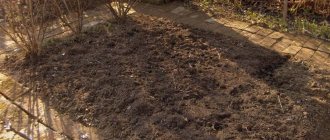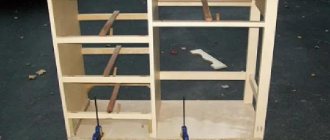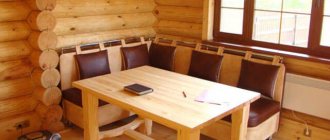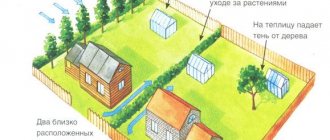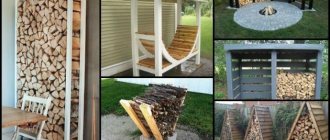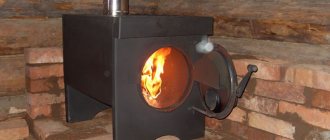Fencing gives garden beds more than just aesthetics. The sides prevent soil from spreading and washing away, and if the bottom of the bed is further reinforced with steel mesh, the plantings will be 100% protected from moles and other pests. To make fences yourself, use any available material. If desired, ready-made boxes can be purchased at the store. Most often, summer residents prefer homemade fences. Brick beds are considered the most reliable, especially if they are high. A solid structure is erected on a foundation, and low brick fences are simply laid along the contour of the bed.
Features of brick beds
The term brick bed refers to a trough-shaped structure. The sides are made of brick with or without mortar. The internal space of the fenced area is filled with a drainage layer and fertile soil, where the planted crops grow directly. Before filling the bed, the turf layer of earth is cut off with a shovel along with the roots of the weeds.
Brick fences for garden beds are durable and beautiful structures
Having decided to create a garden bed out of brick, you need to know its main features:
- The fence is completely stationary. You can't move it. If for some reason this is planned to be done in the future, the brickwork is laid dry without mortar. In this form, the bed can be moved, but with subsequent disassembly and reassembly in a new place.
- Another feature is the height. Depending on the needs, the fence can reach 1 m. High walls are built on mortar with the obligatory laying of a foundation in the form of a concrete strip.
- Brick allows you to create beds of any shape. To obtain smooth curved walls, use halves. The ridges are laid out triangular, polygonal, round, oval, square. By combining the ratio of shapes and heights, interesting structures are obtained.
Brick is considered a universal building material. A fence made from it will suit any design of the site. The garden bed will fit into the architectural ensemble and give it originality.
How to prepare for planting?
There is no need for special preparation for planting a newly created bed. However, already in the 2nd year, 3-5 days before planting, it is necessary to remove the surface covering of the soil, which serves as its protection from pests, and loosen the soil by 10 cm. There is no need to dig with the entire shovel and take out plant residues. After this, walk around the area with a rake and level the ground. To prevent the top layer of the bed from drying out and to heat it up faster, it is recommended to lay a film on top.
Every summer resident dreams of a beautiful and well-equipped plot. There are many ways to create and allocate beds for growing various crops. Thanks to the sides of the structures, the soil is not washed away, and if you put a net on top of the soil, you can protect the plantings from attacks by moles and other pests.
To create fences, any type of available material is used. Sometimes ready-made structures are bought in gardening stores, but recently, summer residents are increasingly building vertical beds on their own. The most popular products are made of brick.
Advantages and disadvantages
Before building a brick fencing for garden beds, it is worth understanding its pros and cons. A detailed acquaintance with all the nuances will make it possible to find the right solution. The review should start with the pros:
- The main advantage of the design is strength. Even with increasing height, a brick fence remains stable and can withstand high soil pressure.
- If the bricklaying technology is followed, the bed will last for decades.
- The fence looks neat and does not lose its attractive appearance throughout its entire service life. No financial investments or large labor costs are required for care.
- A brick wall slowly freezes in the cold and warms up during the heat. Plant roots are guaranteed to be protected from low and high temperatures.
- High fences are sometimes an obstacle for dogs, who can rake through the bed and destroy the plantings. A brick structure cannot be overcome by pests crawling on the ground.
A brick bed has a main advantage - strength
. After reviewing the main advantages, it is worth considering the other side of the coin, that is, the disadvantages:
- The main disadvantage of brick beds is the difficulty of construction. First of all, this concerns labor costs. To make the masonry smooth, you will need patience and experience. The process becomes more complicated when it is additionally required to pour the foundation, to drive out high walls with mortar and jointing.
- The bed cannot be moved. If the brick is laid without mortar, the issue is still resolved. Dismantling walls built on concrete is tantamount to destroying the material. Most bricks turn into rubble, which is only suitable for filling a ditch.
- On heaving soils, it is better to abandon the beds or you need to build a reliable foundation. Otherwise, the brickwork will crack. The garden bed will take on an obscene appearance.
A brick ridge is considered a complex structure. Changing the shape and size in the future is not so easy, and sometimes impossible. All parameters need to be thought out in advance. The same applies to determining the location on the site.
Using the foundation
What to use the foundation for? Will it be enough to dig the bricks into the ground? The previously discussed methods for constructing a temporary structure are practical and simple, but they are not protected from environmental influences. Soil has the ability to shift and deform over time; if the bricks are not fixed evenly and beautifully, they will not last long. Therefore, the foundation is the best structure on which you can easily build beds using bricks.
Now we will look at the sequential instructions for pouring a strip foundation for a garden bed:
- It would be best to make a rectangular foundation. Then it will be easier to drive one stake at each corner and pull the thread, which will serve as the defining contour.
- The width of the foundation depends on the size of the wall. One brick will be enough for the garden bed. Based on this, 20 cm wide is enough. To prevent the foundation from tilting to one side after some time, it is necessary to make it deeper than 25 cm, or even 30 cm.
- The next step is to dig a trench appropriate to our dimensions. It is very important to take into account the characteristics of the soil. In some areas the soil is hard and slightly damp, in others it is dry and sandy. Where there is sandy soil, trenches should be made slightly wider than the future foundation. In areas where there is hard and moist soil, preferably black soil, it is possible to dig end to end. But we should not forget about the formwork. Along the edges, take into account the thickness of the boards.
- After leveling the bottom of the dug trench, you need to fill it with a little sand in a layer of 15 cm.
- The sand layer also needs to be leveled, then watered and compacted well.
- The foundation should protrude from the ground by about 10 cm; this must be taken into account when installing the formwork.
- After this, waterproofing can be done to prevent the soil from absorbing cement laitance. After laying the roofing material in one layer, begin reinforcing the structure. Thus, strengthening the entire foundation and making it one whole.
Only after such work has been carried out, as well as the concrete has completely dried, should you begin to lay bricks. Drying ideally takes 14 days, but this is relative, it is necessary to take into account the climate and weather, in the summer heat the concrete will dry quickly, in a humid and cold period it will take longer.
Types of brick beds
There are many varieties of ridges. All of them differ not only in appearance, but also in design features. If we conditionally group them and divide them into types according to basic parameters, we get 4 groups:
- High beds reach a height of up to 1 m. A foundation must be poured under them. Brick laying is done using mortar.
- The brick-lined ridges are distinguished by a slight elevation above ground level. Usually this is a border type edging, consisting of 1-2 rows of bricks.
- Figured beds have a special decorative effect. They are high on the foundation and low curbs. Any shape except the classic rectangle. Curved fences are often created in groups that form the main pattern of a large ridge
- Do-it-yourself greenhouse beds are most often laid out from old brick, since decorativeness is not important here. The height varies, depending on the crops grown using a certain technology. Curly shapes are not needed here. The beds are made rectangular, with a limited width for ease of maintenance. The length can be the entire length of the greenhouse.
Each type of bed is designed for a specific use. If organic matter is to be added, the sides are made high. For a simple fence, it is enough to remove 1-4 rows.
What crops can be planted in high beds
Here you can grow almost everything that you plant in your regular garden - vegetables, berries, herbaceous plants, etc. The structures are suitable for the effective cultivation of strawberries, wild strawberries, and various flowers. By slightly modifying the frame, such beds can easily be turned into a greenhouse, which is very easy to maintain. In these greenhouses, tomatoes, cucumbers and other vegetable crops grow well, requiring protection from precipitation and frost in the spring.
Among flower crops, the biggest fan of high beds is Petunia. It flows beautifully down the structure, creating a unique living decoration.
Get creative with growing plants and placing raised beds on your property to create a beautiful and useful decoration for your garden plot.
How to make brick beds with your own hands
Ridge fencing is constructed in two ways: a high wall and a border of 1-2 bricks. The first option is difficult. The large weight of the structure requires pouring a concrete strip. It is advisable to reinforce the base to prevent cracking during spring soil movement. The rows are laid using cement mortar. Using a level and a marking cord, check the evenness of each tier. The width of the main wall is from 1 to 1.5 bricks.
The second option is simple. Essentially, this is edging the beds with bricks dry without mortar. Usually lay out 1-2 rows. The width of the border is half or one brick. Often they are simply dug in, creating a thin edging.
The evenness of the masonry rows is checked with a level
It is important to choose the right building material. If there is no foundation, only red solid bricks are laid on the ground. They are not destroyed by moisture. White sand-lime or facing bricks are laid on an elevated foundation. Hollow blocks are not used. Moisture that gets inside the air holes will turn into ice in the cold. The expansion will tear the wall apart.
DIY raised beds made of brick
A distinctive feature of a high ridge is its heavy weight. A concrete strip is poured under the wall. It will take a lot of solution. It is easier and faster to mix it with a concrete mixer. The materials used are red or white brick, reinforcement, cement, dry sand, and crushed stone. We also need boards or pieces of plywood and sheet metal to install the formwork.
For a high ridge, a concrete base is poured and spoon masonry is used
Step-by-step instructions for making a brick bed with your own hands include the following work:
- Construction begins with marking the site. Pegs are driven into the ground and the cord is pulled. Dig a trench 50 cm deep. The width depends on the thickness of the walls. Typically, the concrete strip is poured so that it protrudes 5 cm on each side of the masonry.
- The bottom of the dug trench is covered with a layer of sand 15 cm thick. The cushion is moistened with water.
- Formwork is installed along the perimeter of the trench. It is enough to secure boards 20 cm wide with stakes. A reinforcing frame made of reinforcement is laid inside the trench. The rods are tied with knitting wire in two rows. The trench is filled with concrete mortar and crushed stone. The foundation is made rising 15 cm above ground level. The concrete strip is allowed to harden for about three weeks.
- Wall laying begins from the corners. Gradually connect them in rows. Verticality is checked with a plumb line, horizontality with a level.
Laying the walls begins at the corners, after which they are connected in rows. Tip!
To make the rows even, pull the cord from opposite corners. The height of the walls is adjusted from 40 to 100 cm. If no other finishing is expected, the joints are unstitched. It is advisable to cover the top of the walls with any cladding. It will prevent water from penetrating into the seams, which could cause the entire masonry to collapse.
To create a warm bed, the internal space is filled in layers with organic matter.
Brick-lined beds
For the simplest edging, a foundation is not required. The advantage of such a structure is not only its simplicity. If necessary, it can be disassembled and moved to a new location.
To cover a bed with bricks, use one of the following methods:
- stack blocks on top of each other diagonally;
- arrange the edging in 1-2 rows without burying the blocks in the ground;
- lay out the edging in 1 block, buried end-to-end in the ground.
The diagonal layout forms a jagged border. The manufacturing technology is based on digging a shallow trench around the perimeter of the bed. The bottom is sprinkled with sand. The bricks are installed at an angle so that the end of their long side rests on each other. In this position they are compacted with soil. Sometimes they use liquid cement, but if disassembled, each brick will have to be cleaned of mortar.
To obtain a jagged border, bricks are laid at an angle
When the path between the beds is paved with paving slabs, the border is laid out in one brick. When laying the block in height, it is buried halfway, having first dug a trench. You can refuse to deepen the edging, but then the bricks are laid flat on the ground surface. In this position, the blocks are stable and do not move during excavation work in the garden bed.
An even border with one brick looks beautiful on the beds, the paths between which are lined with tiles or crushed stone
DIY figured brick beds
For figured beds, not only strength is important, but also decorativeness. Place them in a visible place in the yard or local area. Most often they use facing bricks, but ordinary ones will do.
Curly fencing is installed in a visible area
Laying out the brick beds shown in the photo with your own hands is not so easy. The same applies to other figured fences. Complex markup will be required. Pieces of bricks are used to create curved shapes. Sometimes they alternate laying rows with the end and flat. High walls are erected using mortar. A simple border is laid out on the ground or slightly buried.
How to make brick beds in a greenhouse
A special feature of greenhouse beds is their rectangular shape. No ovals, polygons or other shapes are needed here. Inside the greenhouse there is a constant damp climate. Only red, solid bricks are suitable. Whether to lay the fence on a foundation or without it depends on the intended purpose of the ridge.
Inside the greenhouse, the ridges are made rectangular in shape.
Long ridges along the walls of the greenhouse are considered a classic. Their width is about 80 cm for ease of maintenance. If the greenhouse is wide, make several long ridges. Paths are built between them. When it is intended to grow many different crops, the greenhouse is divided into small sectors in beds.
The technology for constructing a fence is no different from structures erected on the street. Low borders for brick beds are laid out dry without mortar. The foundation is poured under the high walls.
Advantages of raised garden beds
Experienced gardeners use raised beds, eliminating a lot of gardening problems:
- You avoid using local, infertile soil because you fill each bed with an individual mixture of soil and compost.
- If desired, watering can be built into the walls of the bed or under it.
- Exposure to the sun warms the frame of the beds, allowing for increased plant diversity and extending the growing season.
- Plants can be located close to each other, this increases productivity, increases the efficiency of irrigation, and crowds out weeds.
- Almost complete absence of weeds and pests.
- Tall structures make physical work easier for the gardener - there is no need to bend over and be in this position for hours. This simplifies work such as planting, weeding and harvesting.
- Raised flower beds are the most productive and visually appealing.
- It is easier to protect the soil from frost; you just need to cover the plantings with plastic wrap.
Flowerbeds are created from any building materials, including stone, brick, concrete and cinder blocks.
But the most popular material for raised beds is wood. The main caution is to get rid of wood that has been treated with toxic chemicals.
You can also read the article “Growing vegetables in raised beds“
Advice from professionals
At first glance, edging ridges with brick fences seems like a simple matter. In fact, here you need to know the requirements for structures and the intricacies of construction. Advice from professionals will help you avoid making serious mistakes:
- High ridges are filled with a substrate, prepared soil or organic matter. You cannot walk on the filler. To make it convenient to serve plants from both sides, the width of the fence is made to a maximum of 1.2 m. If it is possible to approach from one side, the parameter is reduced to 0.8 m.
- To maintain moisture, the soil on high ridges is mulched. Peat, sawdust, small straw and other dry organic matter are suitable.
- It is better to organize drip irrigation with automated water supply.
- Before loading the soil, the bottom of the pit is covered with galvanized mesh. It will protect the entry of rodents from the garden.
- To maintain soil nutrition, organic fertilizers are periodically applied.
- Before wintering, the soil is covered with leaves, sawdust, and straw. Organic matter will reduce the likelihood of soil freezing and destruction of useful components.
It is easier to lay out fences along a stretched cord
. By following the simplest tips, a gardener will greatly facilitate his task of caring for plantings.
